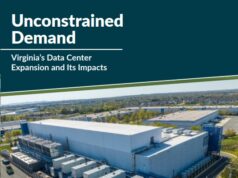by Ivy Main, cross posted from Power for the People VA
Virginia’s General Assembly made history in 2020 by becoming the first state in the South to pass a law requiring the full decarbonization of its electric sector. The Virginia Clean Economy Act requires our two largest utilities, Dominion Energy and Appalachian Power, to close all Virginia carbon-emitting power plants by 2045. As of 2050, the state will not issue carbon allowances to any other power plants in the commonwealth, including those owned by electric cooperatives and independent generators.
Less than a year later, President Joe Biden wants to move up the date for a carbon-free electric grid nationwide to 2035. Biden is also targeting a net-zero carbon economy by 2050. On that, Virginia is actually more ambitious, at least on paper, since the Commonwealth Energy Policy sets a goal for a net-zero economy by 2045.
But the electric sector has to come first, mainly because it’s the linchpin for reductions in the rest of the economy. Clean electricity allows for clean transportation when cars, trucks and buses are electrified, and for clean buildings when gas heating and gas appliances are replaced with electric. It’s harder to zero out emissions from industry and agriculture; we do need more time to develop cost-effective solutions for those.
The good news is the U.S. is already halfway to zero, according to a new report from Lawrence Berkeley National Laboratory that compared CO2 emissions from the power sector today to projections 15 years ago. But a lot of that achievement came from replacing coal with fracked gas, with energy efficiency and renewables making up the rest. From here on in, efficiency and carbon-free sources have to carry the whole load.
What would it take for Virginia to achieve a carbon-free grid just 14 years from now, half the time allowed by the VCEA? Questions fall roughly into three categories: cost, feasibility and reliability. All three will be easier to overcome if the whole country is working together towards a single goal, especially if the federal government does more than just point the way. But there’s a strong case for optimism regardless.
Cost
Cost is the biggest concern in the minds of most people, but it shouldn’t be. It’s been three years since solar became the cheapest form of new power generation in Virginia, and prices continue to drop. The International Energy Administration declared last year that falling prices mean solar is “becoming the new king of the world’s electricity markets,” poised to become the primary source of new electricity generation worldwide by 2030. (Did you read about the solar project in Saudi Arabia that will deliver solar at barely over a penny per kilowatt-hour?)
Wind has been the cheapest form of generation for years in many states, and its price is still falling. Of course, for Virginia the big wind opportunity lies offshore. Offshore wind technology is still in its infancy in the U.S., making it relatively expensive, but its price trajectory is also steeply downward. Once the industry scales up and American manufacturing, supply chain and workforce replace European imports, prices will fall further — though it may never match solar on price.
The only expensive part of an all-renewables scenario right now is the challenge of keeping supply in sync with demand. But as with wind and solar, the cost of battery storage technologies has been falling.
Meanwhile, what happens to our existing fossil fuel plants? Closing coal plants was already the right move for consumers. Virginia’s few remaining coal plants don’t run much and are money sinks. Dominion’s newest coal plant, for example, has a 10-year net present value of negative $472 million. Shuttering coal plants will save money today as well as speeding us along the path to zero carbon.
By contrast, we have a lot of gas plants that currently make money, so our utilities are even more loath to plan for their demise. Dominion spent most of the last decade building out a huge fleet of natural gas combined-cycle plants on the theory that fracking would make gas a cheap fuel forever. The theory ignored the growing competitiveness of wind and solar that was evident even early on in the building spree. This isn’t just hindsight talking; in 2013 I wrote that Dominion’s newly-approved 1,358-megawatt Brunswick County Power Station was destined to become a giant concrete paperweight as clean energy displaced fossil fuels. Yet a few years later Dominion added to its paperweight collection with the even larger Greensville County Power Station.
In both cases the equally short-sighted State Corporation Commission approved these investments, so bad luck, ratepayers: we are stuck paying off the capital costs whether the plants run or not. That does not mean we have to operate them; projections show that by 2030 it will be cheaper to turn gas plants into solar panel factories while we run our grid on wind and sunlight.
Feasibility
A rapid transition to a carbon-free grid poses logistical challenges. We need enough suitable land to hold all that solar. (Agrivoltaics will help.) The federal government needs to identify new areas of the ocean for offshore wind turbines. We also need solutions to seasonal fluctuations in demand. We need new transmission lines. We need enough lithium for batteries, steel for turbines, silicon for solar and a trained workforce, stat!
Federal coordination will be key to solving many of these challenges, but we can also reduce land acquisition and transmission barriers if we don’t insist on replacing large, utility-owned fossil fuel power plants only with large, utility-owned wind and solar farms. Virginians will benefit far more if we prioritize solar and storage on rooftops, parking lots, brownfields, closed landfills and rights-of-way. That’s not just about space, but about assigning value to benefits like storm resilience, emergency preparedness and local jobs.
For the same reason, we should insist on building homes better. Houses that are well insulated need less heat in the winter and air conditioning in the summer, reducing the problem of seasonal swings in energy demand. (They are also healthier and more comfortable.)
Reliability
A rapid transition to a carbon-free grid is a climate imperative, but it’s still a tall order for a utility or a regulator whose job it is to keep the lights on. Batteries, energy efficiency and demand response programs can do only so much. Planners will also have to factor in the likelihood that by 2035, many vehicles will be electric, and electricity will replace gas appliances in new buildings and retrofits. Balancing supply and demand 24/7 with just today’s tools would not be an easy job.
And, fortunately, they will not be working with today’s tools. The pace of change in energy and computer technology over the past 14 years will be matched or exceeded by the pace of the next 14. Green hydrogen gets all the press, but hundreds of other innovations will also combine to make a zero-carbon energy supply feasible and reliable — and, not incidentally, far better for people and the planet than what we have now.
In fact, we are witnessing the launch of a new era in energy, what Tony Seba’s RethinkX Project calls “the fastest, deepest, most profound disruption of the energy sector in over a century,” driven by low-cost solar, wind and battery storage (SWB).
The Project’s report Rethinking Energy 2020-2030 puts it this way: “The SWB disruption of energy will closely parallel the digital disruption of information technology. Just as computers and the Internet slashed the marginal cost of information and opened the door to hundreds of new business models that collectively have had a transformative impact upon the global economy, so too will SWB slash the marginal cost of electricity and create a plethora of opportunities for innovation and entrepreneurship. What happened in the world of bits is now poised to happen in the world of electrons.”
So, a carbon-free grid by 2035? Bring it on, President Biden. Virginia is ready.
A version of this article ran in the Virginia Mercury on April 16, 2021.













